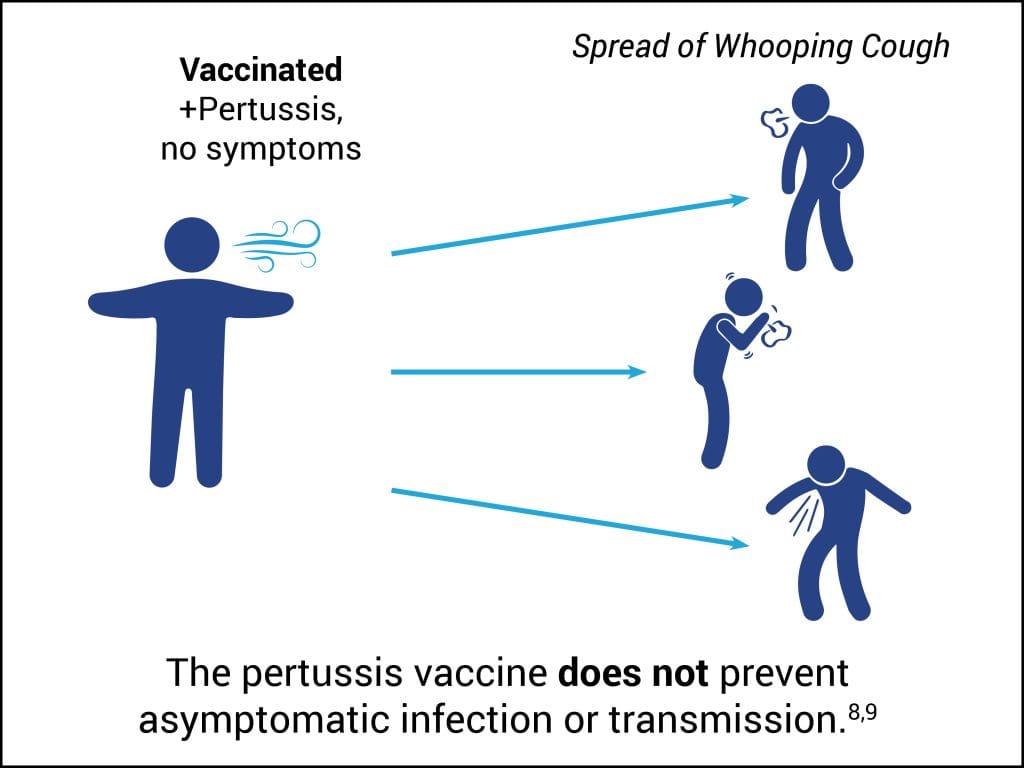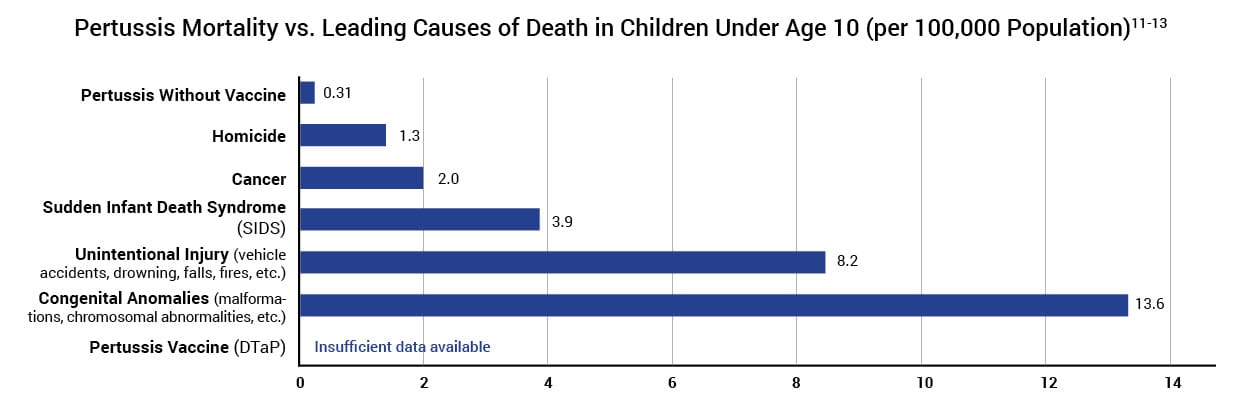Pertussis (Whooping Cough):
What You Need to Know
 1. WHAT IS PERTUSSIS?
1. WHAT IS PERTUSSIS?
Pertussis is a bacterial infection.
- Pertussis symptoms include an initial phase of symptoms similar to a common cold (runny nose, sneezing, low-grade fever, and a mild cough).1 After 1–2 weeks, some cases develop bursts of numerous rapid coughs usually accompanied by a high-pitched whoop.2
- Infected adolescents and adults typically have milder symptoms than infants and young children.2
- About 82% of pertussis infections are benign and not reported to public health departments.3
- Before the pertussis mass vaccination program was introduced, nearly all pertussis cases occurred in children of age 9 or younger.4
- In rare situations, pertussis can be fatal. Most fatal cases of pertussis occur during infancy, before age 1.5

2. WHAT ARE THE RISKS?
In the modern era, it is rare to contract a fatal case of pertussis in the United States. Between 1900 and 1945, before widespread use of the pertussis vaccine began, the mortality rate of pertussis dropped from 16.1 per 100,000 to 1.3 per 100,000 in the population, due to advancements in living conditions, nutrition, and health care — a 92% decline (Fig. 1).6
Research studies estimate that, in the absence of mass vaccination, the risk of an infant younger than age 1 contracting a fatal case of pertussis in the U.S. in the 21st century is about 1 in 46,000 or 0.002%.7

Figure 1: The pertussis death rate declined by 92% from 1900 to 1945, before widespread use of the pertussis vaccine in the late 1940s.
 3. WHAT TREATMENTS ARE AVAILABLE?
3. WHAT TREATMENTS ARE AVAILABLE?
Because pertussis resolves on its own in most cases, usually only supportive care is necessary. Treatment options include the following:
- Rest
- Hydration
- Antibiotics — options include azithromycin, clarithromycin, erythromycin, and trimethoprim-sulfamethoxasole2
4. WHAT ABOUT THE PERTUSSIS VACCINE?
Widespread use of the pertussis vaccine in the U.S. began in the late 1940s, and the pertussis vaccine was combined with diphtheria and tetanus toxoids (vaccines) as DTP in 1948. It has significantly reduced the incidence of reported (i.e., noticeable) cases of pertussis infections; however, a U.S. Food and Drug Administration (FDA) study indicates that the vaccine does not prevent asymptomatic infection or transmission.8,9

The manufacturer’s package insert contains information about vaccine ingredients, adverse reactions, and vaccine evaluations. For example, the pertussis vaccine “has not been evaluated for carcinogenic or mutagenic potential or impairment of fertility.”10 Furthermore, the risk of permanent injury or death from the pertussis vaccine has not been proven to be less than that of pertussis (Fig. 2).11
Figure 2: This graph shows the pertussis death rate in the absence of mass vaccination and compares it to the leading causes of death in children under age 10 today. Hence, in the absence of mass vaccination, the pertussis death rate per 100,000 is 0.31 for children under age 10. In 2015, the death rate per 100,000 for homicide was 1.3, followed by cancer (2.0), SIDS (3.9), unintentional injury (8.2), and congenital anomalies (13.6). The rate of death or permanent injury from the pertussis vaccine is unknown because the research studies available are not able to measure it with sufficient accuracy.
REFERENCES
- Centers for Disease Control and Prevention. Epidemiology and prevention of vaccine-preventable diseases. 14th ed. Hall E, Wodi AP, Hamborsky J, Morelli V, Schillie S, editors. Washington, D.C.: Public Health Foundation; 2021. 240. https://physiciansforinformedconsent.org/cdc-pink-book-14th-edition-2021/.
- Centers for Disease Control and Prevention. Epidemiology and prevention of vaccine-preventable diseases. 13th ed. Hamborsky J, Kroger A, Wolfe S, editors. Washington, D.C.: Public Health Foundation; 2015. 262, 265. https://physiciansforinformedconsent.org/cdc-pink-book-13th-edition-2015/.
- Cherry, JD. Pertussis in the preantibiotic and prevaccine era, with emphasis on adult pertussis. Clin Infect Dis. 1999 Jun;28 Suppl 2:S109. https://pubmed.ncbi.nlm.nih.gov/10447027/.
- Gordon JE, Hood RI. Whooping cough and its epidemiological anomalies. Am J Med Sci. 1951 Sep;222(3): 345. https://pubmed.ncbi.nlm.nih.gov/14877820/.
- National Center for Immunization and Respiratory Diseases (U.S.), Division of Bacterial Diseases, Centers for Disease Control and Prevention. Washington, D.C.: U.S. Department of Health and Human Services. 2014 final pertussis surveillance report; 2015 Oct. https://stacks.cdc.gov/view/cdc/35737.
- Grove RD; Hetzel AM; U.S. Department of Health, Education, and Welfare. Vital statistics rates in the United States 1940–1960. Washington, D.C.: U.S. Government Printing Office; 1968. 559-87. https://stacks.cdc.gov/view/cdc/6200.
- Magno H, Golomb B. Measuring the benefits of mass vaccination programs in the United States. Vaccines. 2020 Sep 29;8(4):4-5. https://pubmed.ncbi.nlm.nih.gov/33003480/; 71% (87) of the 123 pertussis deaths reported in the study were infants less than 1 year of age. Because there are about 4 million such infants in the population, the risk of fatal pertussis for those infants is 87 in 4 million (1 in 46,000).
- Warfel JM, Zimmerman LI, Merkel TJ. Acellular pertussis vaccines protect against disease but fail to prevent infection and transmission in a nonhuman primate model. Proc Natl Acad Sci USA. 2014 Jan 14;111(2):787-92. https://www.ncbi.nlm.nih.gov/pmc/articles/PMC3896208.
- Warfel JM, Merkel TJ. Reply to Domenech de Cellès et al.: infection and transmission of pertussis in the baboon model. Proc Natl Acad Sci USA. 2014 Feb 18;111(7):E718. https://pubmed.ncbi.nlm.nih.gov/24693544/.
- Sanofi Pasteur Inc. Swiftwater (PA): Sanofi Pasteur. Daptacel (diphtheria and tetanus toxoids and acellular pertussis vaccine adsorbed); [cited 2022 Sep 29]. https://www.fda.gov/media/74035/download.
- Physicians for Informed Consent. Newport Beach (CA): DTaP — vaccine risk statement (VRS). DTaP vaccine: is it safer than diphtheria, tetanus, and pertussis? 2023 Nov. https://physiciansforinformedconsent.org/dtap-vaccine-risk-statement/.
- Magno H, Golomb B. Measuring the benefits of mass vaccination programs in the United States. Vaccines. 2020 Sep 29;8(4):4,6. https://pubmed.ncbi.nlm.nih.gov/33003480/; the study observed 123 pertussis deaths nearly all occurring in children under age 10. Because there are about 40 million such children in the U.S., the mortality rate is 0.31 per 100,000.
- Centers for Disease Control and Prevention. Washington, D.C.: U.S. Department of Health and Human Services. 10 leading causes of death by age group, United States—2015. https://physiciansforinformedconsent.org/cdc-leading-causes-of-death-age-group-2015/.
Published 2023 Apr; updated 2024 Aug


